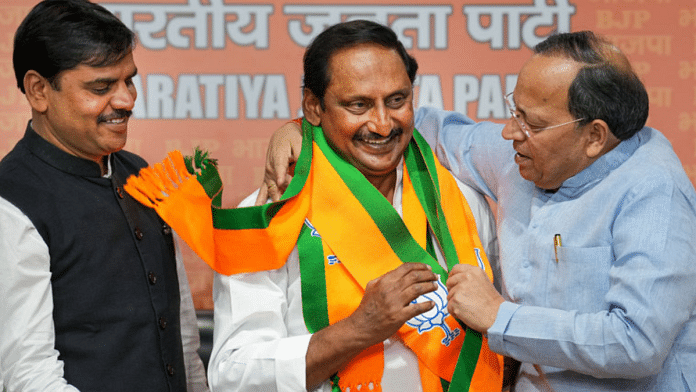Over the last few years, political dynamics in India have evolved remarkably. The Bharatiya Janata Party has significantly revamped its strategies to tap into diverse voter groups. One of the notable transformations in this journey is the party’s attempts to woo the ‘middle castes’.
Historically, in India, caste has played a pivotal role in electoral politics. Not all Scheduled Castes (SCs) or Other Backward Classes (OBCs), the beneficiaries of reservation, are socio-economically marginalised. Many of these caste groups, especially those that can be considered ‘middle castes’, are landowning, dominant, and numerically strong communities that wield considerable economic power. Their significance in electoral politics cannot be overstated, given their ability to influence large vote banks.
These middle castes are often characterised by economic clout, mostly belonging to agricultural backgrounds. In some states, they even fall under the OBC category. They often outnumber voters from other castes. The electorates among the backward castes are also not uniform. These broader categories present a mosaic of underlying tussles among these castes. While the extreme backward castes and classes often rely on government support for survival and hence are influenced by direct support, middle castes dictate their terms to different parties and are in a position to bargain for their benefits.
Yadavs in Uttar Pradesh and Bihar, Jats and Gujjars in Haryana and Rajasthan, Marathas in Maharashtra, Kammas and Reddys in Andhra Pradesh and Telangana, Vanniyars and Gounders in Tamil Nadu could be considered as middles castes.
Also read: 2 reasons why Congress & BJP might not succeed in wooing tribals in Madhya…
Breaking the Brahmin-Bania image
Under Prime Minister Narendra Modi, the BJP has introduced initiatives that target people living below the poverty line. Some of these include Pradhan Mantri Ujjwala Yojana, Pradhan Mantri Awas Yojana, and Pradhan Mantri Jan Dhan Yojana. These schemes are not only social welfare mechanisms but also well-calibrated political moves to expand the BJP’s voter base beyond the traditionally affluent ‘upper’ castes. The successful implementation of these programmes has undoubtedly enamoured the weaker sections of society, including SCs, STs, and some extremely backward classes.
For the BJP, which was characterised as a “Brahmin-Bania” party in the 1990s, this was much needed. If we divide voters into three broad caste categories of OBCs, SC or STs, and upper castes, then we could say that the BJP’s largest traditional voter base was the last group.
After 2014, this trend changed. The party started gaining popularity among SC, ST, and OBC voters. This doesn’t mean that the BJP’s support among the upper castes has declined, though.
However, this political puzzle remains incomplete without the middle castes. These powerful castes were traditionally associated with regional parties. Now, the BJP’s alliance with the Jannayak Janta Party (JJP) showcases the ruling party’s intent to extend its outreach. In Maharashtra, the BJP formed an alliance with Eknath Shinde and Ajit Pawar to make inroads among the dominant Maratha community. Such strategic alliances indicate a tactical shift to integrate these influential caste groups into the BJP’s fold. And this can help the party — if the BJP seeks to retain power, it needs to build on its erstwhile social dynamic by adding these middle castes to the mix.
Not all those belonging to these middle castes are aligned with the BJP, though.
In Uttar Pradesh and Bihar, not many Yadavs support the BJP despite the party promoting leaders from the community in the recent past. Nityanand Rai was made state president and later given the portfolio of Minister of State for Home Affairs. Many were given Rajya Sabha tickets and plum posts in the government and party too. Harnath Singh Yadav, Subhash Yaduvansh, and Sangeeta Yadav were supported by the BJP.
Similarly, in Andhra Pradesh, many big-shot leaders, including Kiran Reddy (former Chief Minister), have joined the party recently. The BJP also appointed K Annamalai as the state president in Tamil Nadu; he belongs to the Gounder community.
Also read: BJP plans Muslim outreach on Uniform Civil Code, will play up ‘3 benefits, boost…
Mission South
The southern states remain crucial for the BJP in its goal to expand its outreach. The party’s presence in South India, barring a few pockets, has been limited. Here, regional parties dominate the political spectrum, having formed caste-based alliances and deeply entrenched loyalties. For the BJP to make significant inroads, it is imperative to tap into the powerful middle castes of this region, especially in Tamil Nadu and Kerala. That can be a game-changer.
The party is already taking several measures to gain influence in the South. Alliance formation, promotion of leaders within middle caste communities, and introduction of targeted welfare schemes — all point to a well-designed strategy. There is a perceptible effort to build and nurture local leadership from influential backward classes, providing them with a platform and voice within the party’s hierarchy. The BJP promoted Vanathi Srinivasan as national president of the party’s women’s wing. She belongs to the Kongu Vellalar community and defeated Kamal Haasan in the Coimbatore assembly election in 2021.
This not only ensures representation but also aids in breaking the stronghold of regional parties over these communities.
The BJP’s strategic outreach to the middle castes underlines Modi’s broader vision to create a pan-India presence. The PM’s ability to adapt and evolve party strategy, based on regional dynamics, showcases his political astuteness. While challenges remain, especially in breaking century-old caste affiliations and loyalties, the systematic efforts to bring middle castes into the fold could redefine India’s electoral politics in the coming years. The political mosaic is indeed changing, and the BJP’s strategies are central to this transformation.
The author teaches Political Science in Satyawati College, Delhi University. He tweets @swadesh171. Views are personal.
(Edited by Humra Laeeq)



